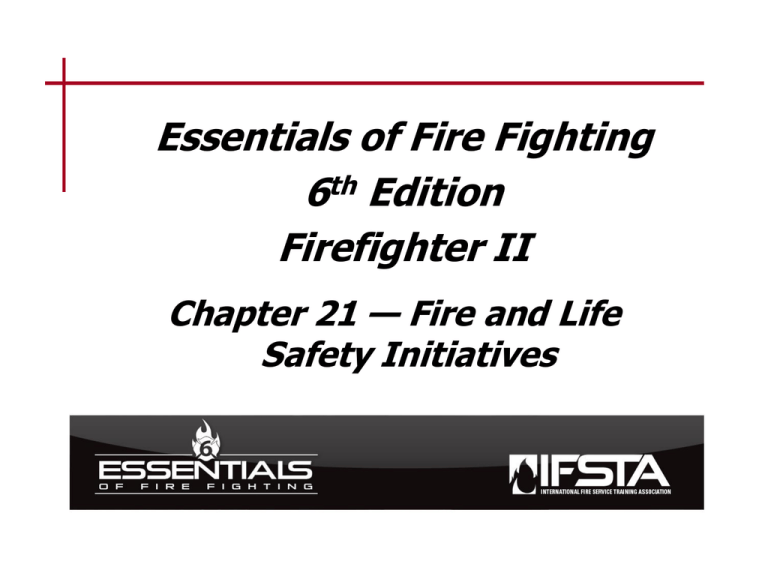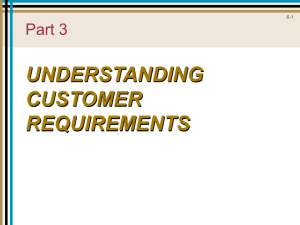Cont.
advertisement

Essentials of Fire Fighting 6th Edition Firefighter II Chapter 21 — Fire and Life Safety Initiatives Learning Objective 1 Describe the role of a Firefighter II in planning for and conducting private dwelling fire safety surveys. 21–1 Private dwelling fire safety surveys are performed on a voluntary basis. Can provide information on amount, kind of safety equipment in home Not subject to same requirements of local codes Survey – Indicate hazards, suggest corrective action Treat as educational opportunity – Not enforcement 21–2 The fire survey is an opportunity to achieve several goals. Recommend actions for eliminating nonfire related hazards Look for common causes of residential fires Look for common causes of fires Complete survey form, provide copy to occupant Educate public 21–3 Planning and public relations are also aspects of these surveys. Advanced planning • Required to gain full acceptance • Prevent accidental fires • Improve life safety conditions Main objectives • Help understand, improve conditions • Citizens know, trust firefighters • Citizens feel department concerned about welfare Benefits of • Increased goodwill can translate into budget support surveys 21–4 These surveys offer several kinds of opportunities. Promote education after identifying hazards Gain information through surveys Use information gathered to meet community needs, generate specific messages Post survey follow up or notification of survey 21–5 Firefighters should take the survey seriously and use several guidelines. Conduct surveys in teams of two or more Dress, act professionally Introduce yourself, your partner, provide proper identification Explain survey procedure (Cont.) 21–6 Firefighters should take the survey seriously and use several guidelines. Maintain courteous, businesslike attitude at all times Focus on preventing fires, eliminating life safety hazards Compliment occupants when favorable conditions are found Offer constructive suggestions for correcting (Cont.) or eliminating hazardous conditions 21–7 Firefighters should take the survey seriously and use several guidelines. Ask to survey all rooms; including garage If accessible, survey basement Ask to survey attic if used for storage or contains heating or cooling unit, is accessible Ask occupant to open any closed doors (Cont.) 21–8 Firefighters should take the survey seriously and use several guidelines. Discuss survey results with owner/occupant, answer any questions Thank owners or occupants for invitation into home Leave behind educational materials appropriate for occupants Keep results of survey confidential; do not share results with any outside entity 21–9 After the survey is completed, there are several actions to take. Post survey • Leave checklist • Give copy of recommendations • Follow SOPs to recommend repairs Leave materials Document • To indicate you tried to contact • Unstamped materials should not be placed in mailbox • Per local SOPs 21–10 REVIEW QUESTION How can a Firefighter II plan for conducting a private dwelling fire safety survey? 21–11 Learning Objective 2 Explain the components that must be considered when developing fire and life safety presentations. 21–12 There are several basic skills to use when presenting safety messages. Audiencecentered Good development of ideas Best choice of words Good organization of ideas Good delivery skills (Cont.) 21–13 There are several basic skills to use when presenting safety messages. Good vocal characteristics Appropriate use of humor Conversational tone Positive attitude Personal style Know your topic 21–14 Audiences will vary and are divided into several categories. Present the message • Based on demographics • If more than one – Prepare for the more challenging (Cont.) 21–15 Audiences will vary and are divided into several categories. Age Educational level Cultural diversity Socioeconomic Physical ability 21–16 Fire and life safety messages need to meet certain criteria to be effective. Accurate • Use developed resources • Guidelines for answering questions Positive • Remember positive rather than negative • Instruct what to do, not what not to do 21–17 Targeted • Based on several factors • Life changing events • Seasonal messages You should use one of several patterns to organize your message to help make it understandable. Knowntounknown Simpletocomplex Wholepartwhole 21–18 Step-bystep REVIEW QUESTION What components must be considered when developing fire and life safety presentations? 21–19 Learning Objective 3 Recognize considerations that must be addressed when giving presentations to young children and fire station tours. 21–20 Presenting to young children requires addressing specific considerations. Classroom considerations 21–21 (Cont.) Presenting to young children requires addressing specific considerations. Children’s common fears Appropriate vocabulary (Cont.) 21–22 Presenting to young children requires addressing specific considerations. Learning style 21–23 Fire station tours provide several opportunities you need to understand. Enhance department’s public image Provide fire and life safety messages Distribute safety awareness literature May be spur-of-the-moment or scheduled 21–24 Fire station tours require planning and following of safety guidelines. (Cont.) 21–25 Fire station tours require planning and following of safety guidelines. Decide where group goes in case of alarm • Decide with officer in charge • Explain before tour 21–26 Remember impressions left will be strong ones • Turn off TVs • Present professional workplace (Cont.) CAUTION Provide safety instructions at the beginning of the tour about what to do and where to go if an alarm sounds during the tour. 21–27 Fire station tours require planning and following of safety guidelines. Answer all questions • Courteously • To best of ability 21–28 Follow local SOPs regarding • Climbing on apparatus • Pictures • Trying on protective clothing (Cont.) Fire station tours require planning and following of safety guidelines. Station mascots Demonstrate equipment, apparatus with caution Do not allow to roam unescorted • Meet upon arrival • Keep together until tour begins • Position to prevent visitors straying • Exercise caution when activating sirens 21–29 • Can be liability • May need to restrict presence REVIEW QUESTION How can firefighters help address the fears of small children during fire and life safety presentations? 21–30 Learning Objective 4 Describe the role of a Firefighter II in planning for and conducting preincident planning surveys. 21–31 Preincident planning surveys gather information before an emergency occurs. May assist with • Locating, controlling fire • Locating occupants • Determining potential hazards • Improving emergency operations • Improving both firefighter, occupant safety 21–32 Documentation for preincident planning surveys show specific details and are used to reach several goals. Details Goals • Construction type • Floor plan or layout • Contents • Occupancy type • Hazardous materials storage • Special processes • Fire detection and suppression systems • Fuel load • Become familiar with structures • Recognize existing hazards • Visualize how standard tactics may or may not apply • Develop new tactics if necessary • Determine if occupants have conditions that may prohibit self-evacuation • Determine if occupants may require translators 21–33 Preincident and code enforcement surveys are separate types of surveys. Preincident Inspections • Become familiar with structure • See if occupants complied with codes 21–34 Preincident planning surveys generally follow the same steps. Follow local SOPs Obtain floor plans (Cont.) 21–35 Preincident planning surveys generally follow the same steps. Conduct thorough survey May need more than one visit Survey buildings separately Discuss results with owner/occupant 21–36 Maps, drawings, and photographs can provide useful documentation. Helpful to firefighters Contain information May be prepared by insurance carriers If unavailable or outdated Include plot drawing Note other important features, information 21–37 (Cont.) Maps, drawings, and photographs can provide useful documentation. Use common symbols Courtesy of Sanborn Map Company 21–38 (Cont.) Maps, drawings, and photographs can provide useful documentation. May create with Geographic Information System (GIS) Other electronic mapping program Take photographs if permitted Captures detail not in drawings Most useful in preincident plans Take from elevated position if possible Interior, close-ups effective Video may be made for training if possible 21–39 REVIEW QUESTION What can a Firefighter II do to prepare for conducting a preincident planning survey? 21–40 Summary • Fire and life safety initiative programs benefit both the community and the fire department. • Firefighters are an important part of that initiative by providing information to the public and preparing to respond to emergencies by surveying occupied properties. 21–41 Learning Objective 5 Conduct a fire safety survey in an occupied structure. This objective is measured in Skill Sheet 21-II-1. 21–42 Learning Objective 6 Make a fire and life safety presentation. This objective is measured in Skill Sheet 21-II-2. 21–43 Learning Objective 7 Conduct a fire station tour. This objective is measured in Skill Sheet 21-II-3. 21–44 Learning Objective 8 Prepare a preincident planning survey. This objective is measured in Skill Sheet 21-II-4. 21–45







